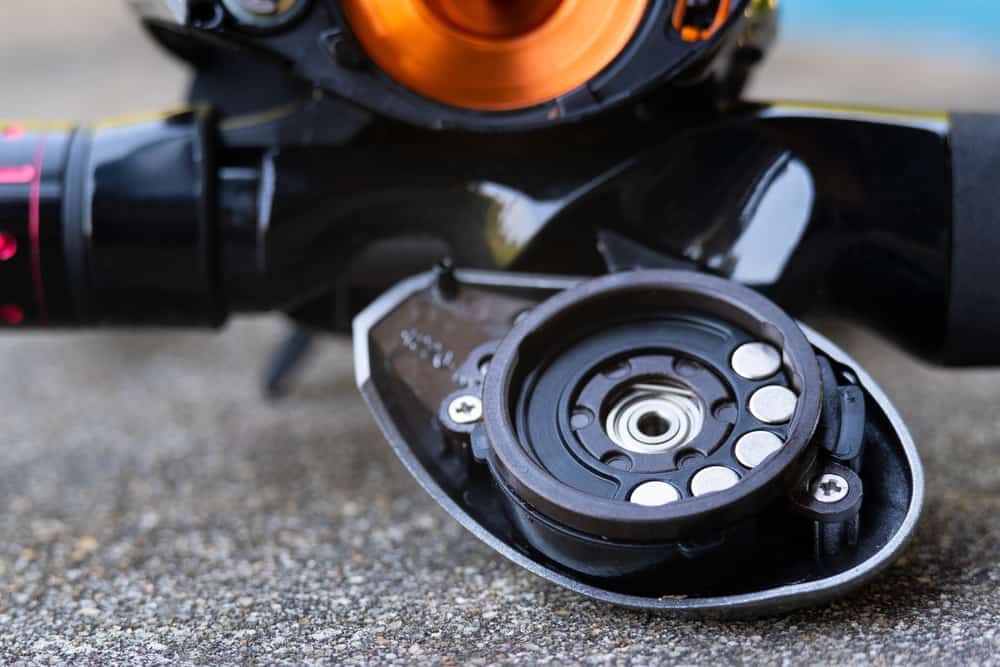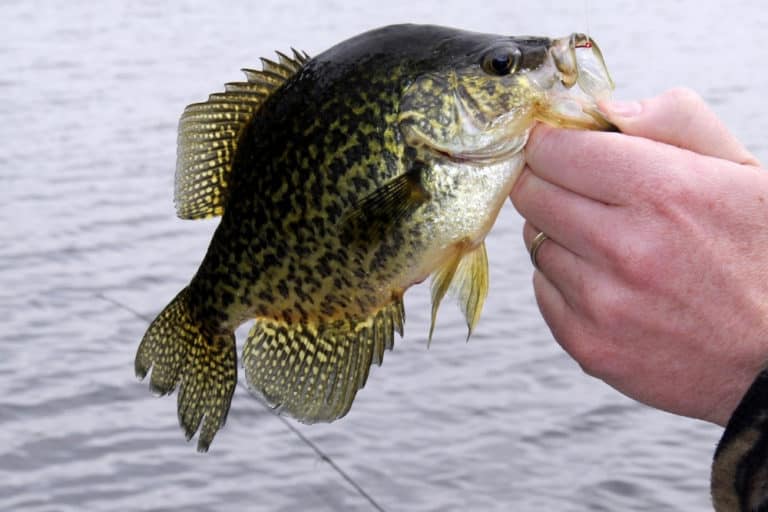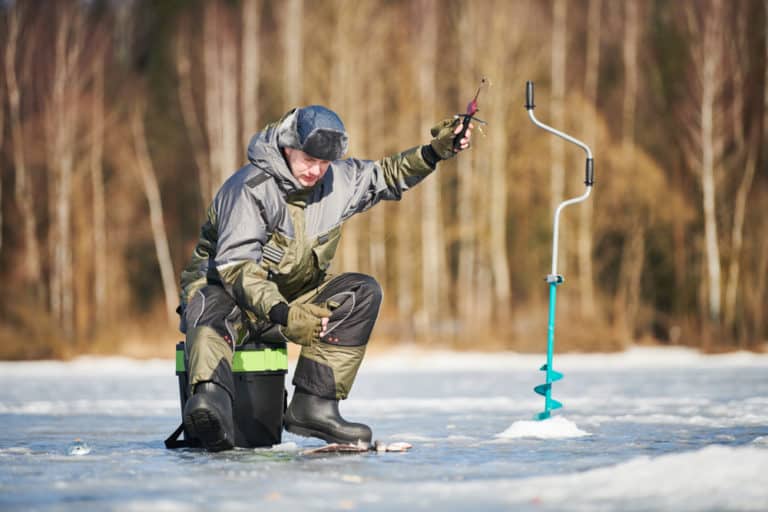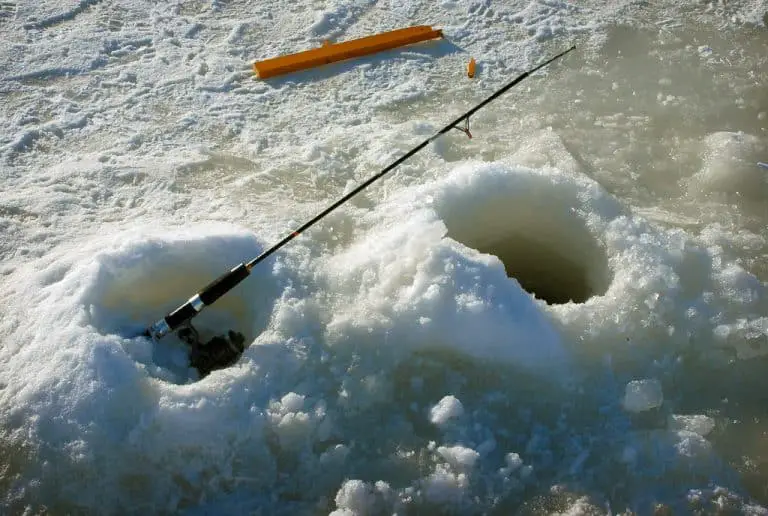How To Set The Magnetic Brake On A Baitcaster
Setting up your baitcaster correctly can completely change your fishing skills. Lots of anglers avoid using their brake and instead rely on the tension of the line to reel their catch in. This method of fishing will wear down your equipment and will give you less control!
To make sure your equipment doesn’t fail on you, and to give yourself the best start on your day of fishing, you will need to learn how to set up your bait caster. We will be mostly focusing on magnetic brakes today, but we have also made some notes on the hybrid versions which have gained some popularity.

Table of Contents
How Do Magnetic Brakes Work In Baitcaster
Magnetic brakes are super easy to use once you learn the mechanics.
Any brake system on your bait caster is designed to prevent blacklashes and tangles on your reel. These types of entanglements happen when your lure hits the water, which instantly slows down its speed.
Without a brake to control the line’s momentum, the spool will continue to release, causing the line to bunch up and tangle.
The brake’s job is to slow down the speed of the spool as it nears the end of its cast. When the lure hits the water, there will be more tension in the spool, limiting the amount of line that will land in the water.
Magnetic brakes work by using “Lenz’s Law,” which is when a magnetic field reduces the flow of motion due to a magnetic current. For our spools, this means the magnets create an opposing force to slow down its spinning speed.
If you open up your reel, you will see that half of the braking system will have little round magnets inserted into the frame. On the outside there will be a dial, this dial moves the magnets closer to further away from the spool. This, in turn, creates a stronger or weaker magnetic force.
If you put the dial on 10, the magnets will be super close to the spool and will therefore create a super strong stopping force.
If you put the dial on 1, there will still be a stopping force, but it won’t be as strong due to it being further away from the spool.
This means that magnetic brakes are always working on your reel. If you like to have complete control of your brakes, then this constant pressure might be too restrictive for you.
How To Set Magnetic Brake On Baitcaster
As your magnetic brake is always working, there is nothing you need to do to set it up. Ideally, you should turn the knob to the halfway point, which is normally 5. Then you can test to see if this level of resistance is enough for your casting distance.
Frequently Asked Questions
You should now understand how to use your magnetic brake, however, we would be surprised if you left this article without any further questions. So we have thought of a couple of issues you might be worried about.
How Do You Adjust The Magnetic Brake On A Baitcaster?
If you were adjusting a centrifugal brake, you would have to uncover the pins by removing the side plate. Then you would have to move these pins into a symmetrical pattern to create a balanced weight and also remove or add pins to make more or less tension.
When it comes to magnetic brakes, all you need to do is adjust the knob to your preferred setting. Again, we would suggest starting at the halfway point and testing the speed of your line. Adjust the knob a couple of times until you reach the level of speed you require.
What Does The Magnetic Brake Do On A Baitcaster?
We have already covered this topic in the “How do magnetic brakes work in baitcaster” section, however, the concept of “Lenz’s Law” might leave you confused.
Basically, magnetic brakes use magnets to slow down the speed of your spool. The lowest settings will still have a magnetic force and so will still cause a controlled speed, but it will be faster than the other settings available to you.
You will find the adjustment dial on the side of the plate, which is opposite to the reel handles.
How Do You Adjust A Dual Braking Baitcaster?
Dual brakes are also known as hybrid brakes, but either name should tell you that they use techniques from both magnetic and the centrifugal systems already available to us.
The centrifugal system uses small weights on the inside of the plates to activate the braking. These are the pins we talked about earlier.
To adjust the weights, you need to unscrew the side or press a lever to release the plate cover.
You will notice that these pins or weights can be moved to “in” or “out” positions. In this scenario, the “out” position means the weight is being used. The more pegs in use mean the slower the reel will be.
Unlike magnetic brakes, centrifugal brakes allow you to have no resistance at all, if you so choose. However, they are a fiddly system to adjust, which does take time.
The dual braking system tries to take the best aspects of both brakes. You can have a fixed set of weights set up for your everyday fishing, but then use the quick changes in the magnets to compensate for wind.
You will need to adjust the weights the same way you would adjust a centrifugal brake, but once your preferred settings have been made, the simple adjustment of the magnetic dial is all you would need on the day-to-day.
How To Test Your Adjustments
To test your adjustment, you should first check that the settings are at the middle point. Starting at this average tension will help you determine if you need a faster or slower adjustment.
Once you are ready, you should make a few easy casts and try to feel how the reel is coping with your adjustments. If your aim is off, or if the line is getting tangled, you should adjust the speeds accordingly. The most important thing you should be searching for is the level of ease you have with each cast.
Starting in the middle might produce some disappointing distances, but remember that the purpose of the brake is to stop backlashes and tangles. Once you are comfortable with the direct and controlled line you have created, you can start to lower the brakes and instead practice thumbing the spool instead.
As you get better and better at casting your lines, you will not need to have high levels of brakes.
No matter your skill level, windy days will give you backlash. When the weather starts to change, you should consider upping your brake levels.






